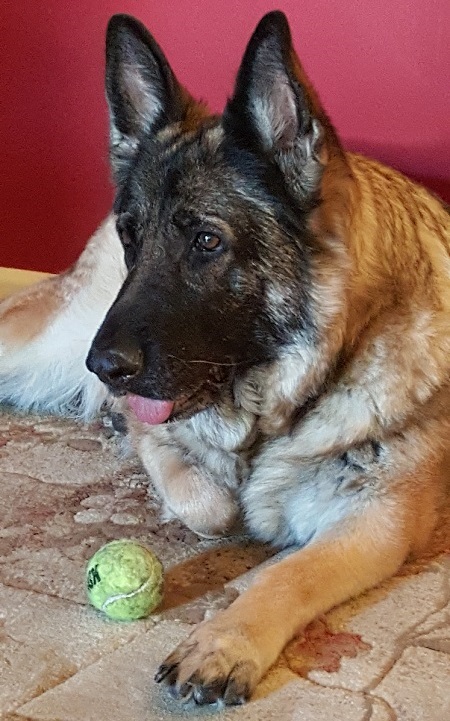
Many dogs and cats develop various lumps and bumps as they age. Some of these are insignificant and small, like skin tags, but others can become irregular large growths that are much more worrisome. Regularly checking with your fingers all areas of your pet’s body can help you find growths at an early stage and facilitate a proper diagnosis and treatment plan.
Our Pet of the Month for August is Xena, a six-and-a-half-year-old German Shepherd dog with a beautiful, thick black and tan coat. Xena has been coming to Hawthorne Hills Veterinary Hospital for a number of years, and stays with us on occasion when her owner is out of town.
As part of every patient’s visit to the hospital, even for nail trims, our veterinary assistants perform a basic physical exam. This helps us stay on top of their overall health and is an opportunity to touch base with pet owners about health issues and to alert the doctors to any changes. In early April, Xena came in for a nail trim. At this particular visit, our team discovered a 3cm nodule on the Xena’s belly that hadn’t been noticed in the past. In fact, Xena had stayed with us for several days in February, and during a physical exam and bath nothing unusual was found. The mass on her abdomen had developed over a very short time period. Because Xena has such a thick coat, it would be easy to miss a nodule, which is why it is so important to be checking on a regular basis.
 Any sort of growth that appears quickly and is increasing in size is always concerning. The location of Xena’s mass next to one of her nipples raised the suspicion for some type of mammary tumor. Xena was scheduled for a full examination with one of our doctors and a fine needle aspirate of the tissue was sent to the laboratory. While not definitive, the cells showed abnormal changes that were very suspicious for mammary gland carcinoma, a type of cancer.
Any sort of growth that appears quickly and is increasing in size is always concerning. The location of Xena’s mass next to one of her nipples raised the suspicion for some type of mammary tumor. Xena was scheduled for a full examination with one of our doctors and a fine needle aspirate of the tissue was sent to the laboratory. While not definitive, the cells showed abnormal changes that were very suspicious for mammary gland carcinoma, a type of cancer.
Dogs and cats who are spayed after they have gone through heat cycles, or who have been pregnant, are at higher risk for developing breast cancer and some types can be quite aggressive. Xena hadn’t been spayed until she was 4 years old when she was adopted by her current owner, so she was in that higher risk group. In order to evaluate the extent of Xena’s disease, we submitted blood and urine to the lab and took chest radiographs looking for any indication of cancer that had spread. Fortunately, all of the tests came back normal.
 Surgery was performed by Dr. Robin Riedinger and entailed removing a wide area of tissue around the mass. The hope was to get all affected tissue and reduce the risk of any recurrence. Xena had to stay quiet for several weeks while her incision healed but she took it all in stride. The doctors, staff and especially Xena’s owner were thrilled to get the report from the lab that the mass, while exhibiting some unusual characteristics, was in fact a mixed mammary adenoma; a benign mass that was completely excised. This was the best news possible.
Surgery was performed by Dr. Robin Riedinger and entailed removing a wide area of tissue around the mass. The hope was to get all affected tissue and reduce the risk of any recurrence. Xena had to stay quiet for several weeks while her incision healed but she took it all in stride. The doctors, staff and especially Xena’s owner were thrilled to get the report from the lab that the mass, while exhibiting some unusual characteristics, was in fact a mixed mammary adenoma; a benign mass that was completely excised. This was the best news possible.
Read More:

 6512 12th Ave NE
6512 12th Ave NE




